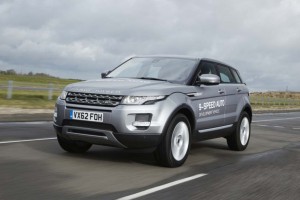Apparently, you can never be too rich, too famous – or have too many gears.
It wasn’t all that long ago when automakers were debating the need to go from four speeds to five — then six, seven and even eight. Now comes Land Rover which has announced it will demonstrate a new 9-speed gearbox in its wildly popular Range Rover Evoque during the upcoming Geneva Motor Show.
But the maker won’t have an exclusive for long. Chrysler CEO Sergio Marchionne recently confirmed his company will start offering a 0-speed automatic also produced by ZF in a variety of its front- and all-wheel-drive models, starting with the all-new Jeep Cherokee to be launched for the 2014 model-year.
(Click Here for more on the 2014 Jeep Cherokee.)
“Increasing the number of gear ratios from six to nine will help reduce emissions and improve efficiency,” notes Land Rover in a statement previewing the Geneva introduction. “Smaller ratio steps also give improved response during acceleration, with improved shift quality and refinement. A higher top gear improves efficiency by lowering engine speed, which also improves comfort and reduces noise when cruising at highway speeds.”
During a news conference at the Detroit Auto Show last month, ZF CEO Stefan Sommer estimated the company’s new 9-speed automatic will be able to reduce fuel consumption by “nearly 13%” compared to older-style 6-speeds.
The lowest gear ratio on the new ZF 9-speed will be dedicated for off-roading, towing and other highly demanding situations such as steep climbs. The new gearbox, meanwhile, introduces a skip-shift function, so it could jump from 6th to 4th, for example, for more aggressive acceleration, or to increase engine braking. The system also monitors the movement of the throttle to anticipate what a driver might want it to do next, something Land Rover dubs “Fast-Off” mode.
Surprisingly, ZF’s 9HP transmission manages to squeeze the extra three gears into a package that’s only a quarter-inch longer than the current Land Rover 6-speed automatic. And the 9-speed weighs 16/5 pounds less by incorporating some innovative technical solutions, including two compact dog clutches that replace conventional clutch packs.
If six speeds are better than four, and nine is better than six, just how much further might manufacturers take things?
There are some downsides to adding more gears, and cost is just one of them, cautioned ZF’s Sommer, acknowledging transmission companies like ZF are likely approaching the limit of how many more gears they can add. The problem is one of mass, inertia and friction, eventually overcoming any potential advantage. Too many speeds can also result in constant “hunting” as an automatic gearbox switches from gear to gear, something studies reveal can disrupt customer comfort.
But, for now, ZF is positioned in the proverbial catbird seat as one of the best-known and most widely respected transmission suppliers. With manufacturers facing a sharp increase in the Corporate Average Fuel Economy standard for 2016 and an even more challenging bump to 54.5 mpg by 2025, the potentially huge benefits offered by the newest gearboxes serves as a siren’s call.
Chrysler is the other maker to confirm it will use a ZF 9-speed, starting with the 2014 Jeep Cherokee and then moving into an assortment of other passenger car and crossover models using transverse-mounted engines, such as the Dodge Dart.
The new 9-speed will be produced at the maker’s plant in South Carolina for use in Land Rover products. But while that facility will supply some of Chrysler’s needs, the U.S. automaker also plans to produce some of the gearboxes at its own transmission plant and pay a licensing fee to the German supplier.
Other automakers are reportedly also negotiating to purchase the new transmission from ZF and it could become widely available by mid-decade, company officials hint, noting they will have the capacity in South Carolina to produce more than 800,000 of the 9HP and another 8-speed automatic.


7-8-9 speed transmissions essentially are reliable CVTs that can handle high loads and torque unlike conventional CVTs. By keeping the engine in a very specific rpm band where torque is high, mpg is improved, which at current prices is a big selling point.
With a properly programmed 7-8-9 speed dual-clutch or auto trans, you can have seemless performance even with small engines in heavier models, again improving fuel economy and customer satisfaction from a small displacement engine.
What intrigues me is the fact that many new products get better mileage with an automatic than with a stick, a reversal of conventional wisdom.
Paul E>